17 min read
On Dec. 8, 1994, NASA announced the selection of its 15th group of astronauts. The diverse group comprised 19 candidates - 10 pilots and nine mission specialists, and included five women, two African Americans, one Asian American, and the first Peruvian-born and Indian-born astronauts. Four international astronauts, one each from Canada and Japan and two from France, joined the group later for astronaut candidate training, following which all 23 became eligible for spaceflight assignment. The two French candidates had previous spaceflight experience in cooperative missions with Russia. All members of the group completed at least one spaceflight, making significant contributions to assembly and maintenance of the space station and carrying out important science missions. Three perished in the Columbia accident.
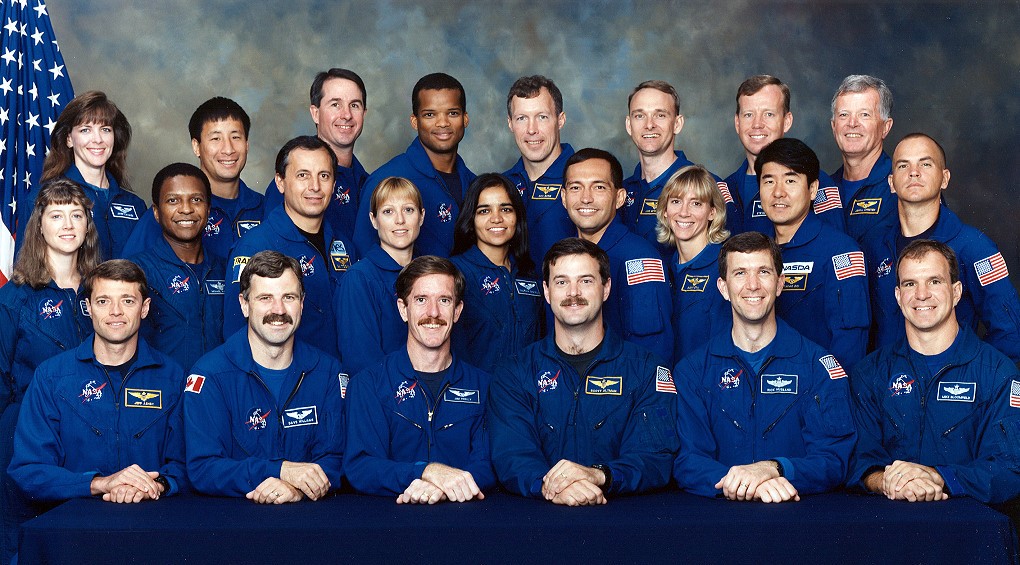
The newest class of NASA astronaut candidates included pilot candidates Scott D. Altman, Jeffrey S. Ashby, Michael J. Bloomfield, Joe F. Edwards, Dominic L.P. Gorie, Rick D. Husband, Steven W. Lindsey, Pamela A. Melroy, Susan L. Still, and Frederick "Rick" W. Sturckow, and mission specialist candidates Michael P. Anderson, Kalpana Chawla, Robert L. Curbeam, Kathryn "Kay" P. Hire, Janet L. Kavandi, Edward T. Lu, Carlos I. Noriega, James F. Reilly, and Steven K. Robinson. A January 1995 agreement among the agencies enabled Canadian Space Agency (CSA) astronaut Dafydd "Dave" R. Williams and Takao Doi of the National Space Development Agency (NASDA), now the Japan Aerospace Exploration Agency, to join the 19 NASA astronauts for training. Another agreement between NASA and the French space agency CNES enabled astronauts Jean-Loup Chrétien and Michel Tognini to also join the group. Both Chrétien and Tognini had previous spaceflight experience through joint agreements with Russia, and their experience proved helpful to NASA in the fledgling Shuttle-Mir Program.
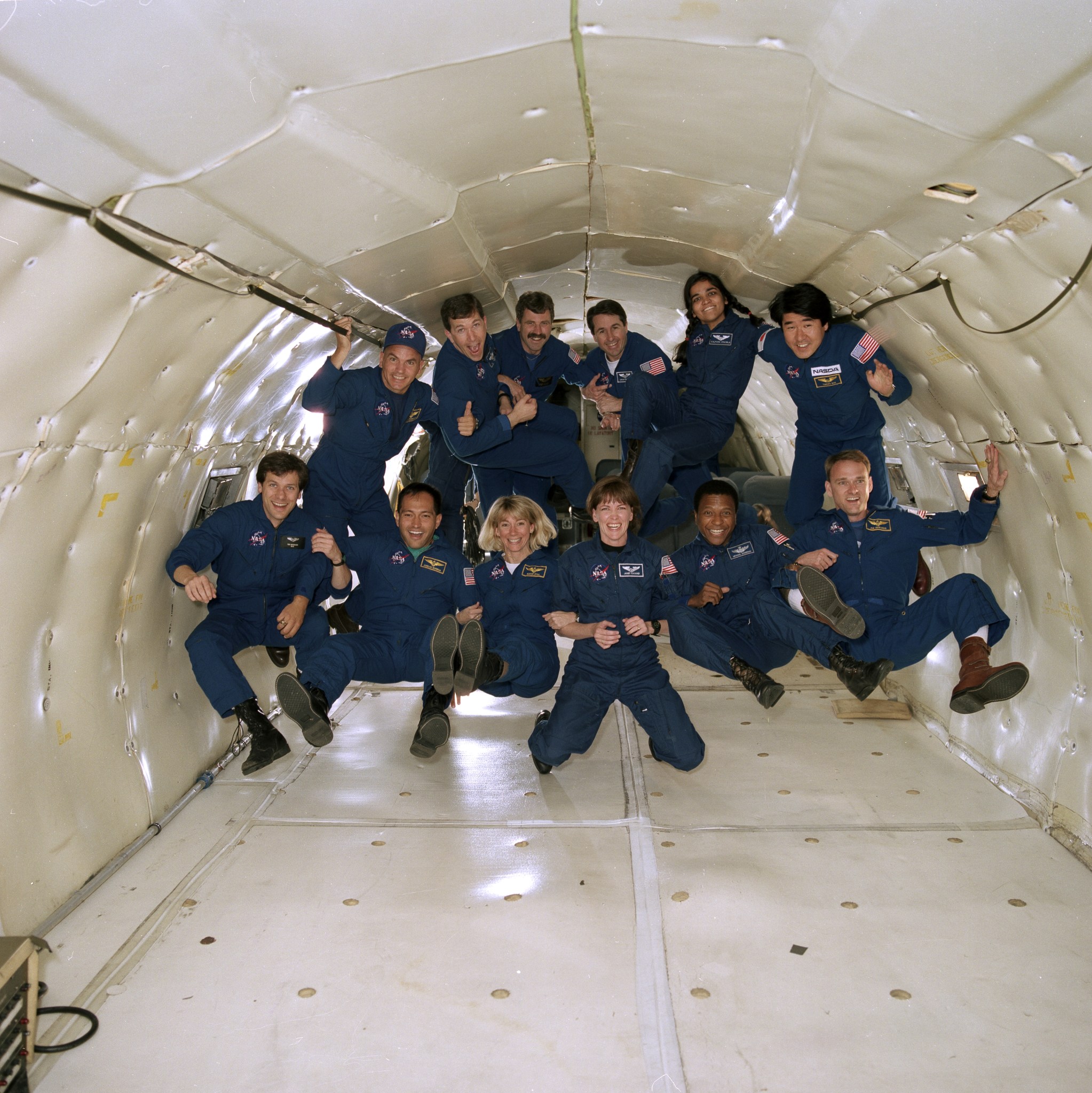
The 19 NASA candidates along with Williams and Doi reported to work at NASA's Johnson Space Center in Houston on March 6, 1995, to begin their one-year training period. The two French astronauts joined them later. During the yearlong training, the candidates attended classes in applied sciences, space shuttle and space station systems, space medicine, Earth and planetary sciences, and materials sciences. They visited each of the NASA centers to learn about their functions and received instruction in flying the T-38 Talon training aircraft, high-altitude and ground egress systems, survival skills, parasail flight, and scuba. They experienced short-duration weightlessness aboard NASA's KC-135 aircraft dubbed the Vomit Comet. After completing the astronaut candidate training, they qualified for various technical assignments within the astronaut office leading to assignments to space shuttle crews.
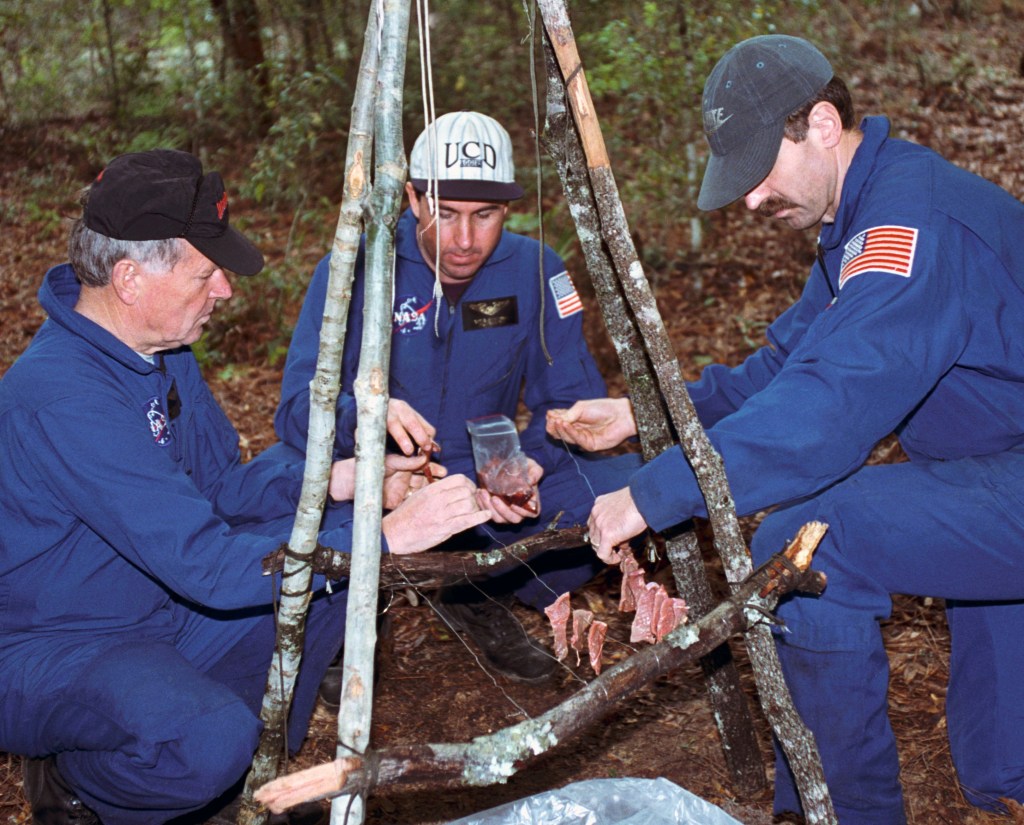
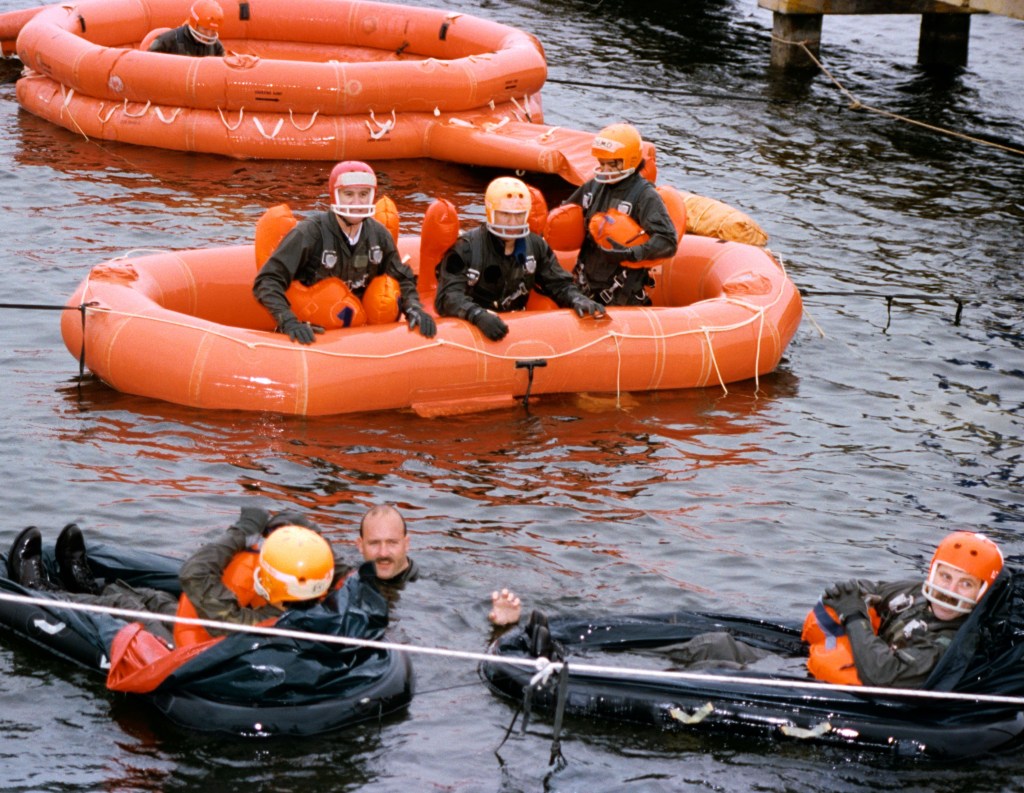
The 19 NASA candidates along with Williams and Doi reported to work at NASA's Johnson Space Center in Houston on March 6, 1995, to begin their one-year training period. The two French astronauts joined them later. During the yearlong training, the candidates attended classes in applied sciences, space shuttle and space station systems, space medicine, Earth and planetary sciences, and materials sciences. They visited each of the NASA centers to learn about their functions and received instruction in flying the T-38 Talon training aircraft, high-altitude and ground egress systems, survival skills, parasail flight, and scuba. They experienced short-duration weightlessness aboard NASA's KC-135 aircraft dubbed the Vomit Comet. After completing the astronaut candidate training, they qualified for various technical assignments within the astronaut office leading to assignments to space shuttle crews.
Per tradition, the previous astronaut class provided the nickname for Group 15. Originally, The Class of 1992, The Hogs, dubbed them The Snails because NASA had delayed their announcement. Then after the addition of the two French astronauts, they felt that The Flying Escargots seemed more appropriate. The Group 15 patch included an astronaut pin rising from the Earth, an orbiting space shuttle and space station, and flags of the United States, Canada, France, and Japan.
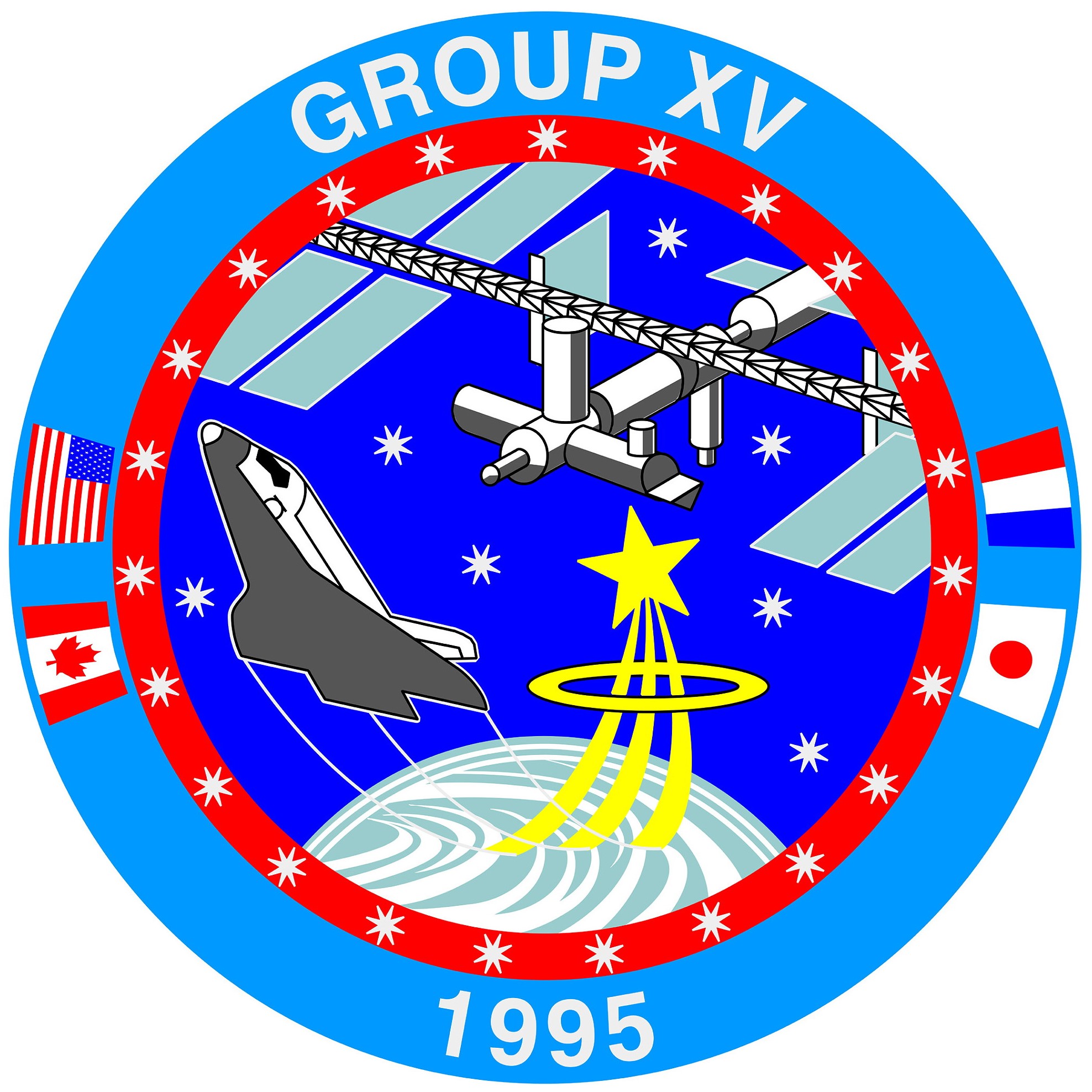
Altman, a U.S. Navy pilot, hails from Illinois. He received his first spaceflight assignment as pilot of STS-90, the 16-day Neurolab mission in 1998, along with fellow Escargots Hire and Williams. He again served as pilot on STS-106, a 12-day space station resupply mission in 2000, accompanied by fellow Escargot Lu. He served as commander on his third mission, STS-109, the 11-day fourth Hubble Space Telescope (HST) servicing mission in 2002. He commanded his fourth and final mission, the 13-day final HST servicing mission, STS-125, in 2009. Altman logged a total of 51 days in space.
Anderson, a native of upstate New York and a lieutenant colonel in the U.S. Air Force, received his first assignment as a mission specialist on STS-89, the nine-day eighth docking with Mir. Fellow Escargots Edwards and Reilly flew with Anderson, who has the distinction as the only African American astronaut to visit that space station during the mission in 1998. He next served as payload commander on the 16-day STS-107 Spacehab research mission in 2003, flying with fellow Escargots Chawla and Husband. Anderson perished in the Columbia accident. He logged nearly 25 days in space.
Texas native and U.S. Navy captain Ashby received his first spaceflight assignment as pilot of STS-93, the five-day mission in 1999 to deploy the Chandra X-ray Observatory. Fellow Escargot Tognini served as a mission specialist on this flight. On his second mission, Ashby served as pilot of STS-100, the 12-day flight in 2001 that delivered the Canadarm2 robotic arm to the space station. Ashby commanded his third and final mission in 2002, STS-112, the 11-day space station assembly flight that delivered the S1 truss. Fellow Escargot Melroy served as pilot on this flight. During his three missions, Ashby spent nearly 28 days in space.
Hailing from Michigan, U.S. Air Force Colonel Bloomfield received his first flight assignment as pilot of STS-86, the seventh Mir docking mission. The 11-day flight took place in 1997, with fellow Escargot Chrétien serving as a mission specialist. Bloomfield served as pilot on his second flight, STS-97, the 11-day station assembly mission in 2000 that delivered the P6 truss and the first set of U.S. solar arrays. Fellow Escargot Noriega flew as a mission specialist on this flight. Bloomfield served as commander on his third and final mission, the 11-day STS-110 assembly flight that delivered the S0 truss segment in 2002. Bloomfield logged a total of 32 days in space across his three missions.
Chawla, the first Indian-born NASA astronaut, earned a doctorate in aerospace engineering. She received her first spaceflight assignment as a mission specialist on STS-87, the 16-day flight in 1997 that carried the fourth U.S. Microgravity Payload (USMP-4). Fellow Escargot Lindsey served as pilot on this mission, during which Chawla used the shuttle's robotic arm to release and capture the SPARTAN-201-4 free flyer. She next served as a mission specialist on the STS-107 Spacehab research mission in 2003, along with fellow Escargots Anderson and Husband. Chawla perished in the Columbia accident. She logged nearly 32 days in space.
On his first spaceflight, Curbeam, a native of Baltimore and commander in the U.S. Navy, flew as a mission specialist on STS-85, a 12-day mission in 1997 that carried the CRISTA-SPAS-2 free flyer. Fellow Escargot Robinson accompanied Curbeam on this mission. On his next flight, he served as a mission specialist on STS-98, the 2001 station assembly flight that delivered the Destiny U.S. Lab. During that 13-day flight, Curbeam participated in three spacewalks, spending nearly 20 hours outside. On his third and final spaceflight, he served as a mission specialist on STS-116, the 13-day assembly flight in 2006 that delivered the P5 truss segment. Curbeam participated in four spacewalks to reconfigure the station's power system, spending nearly 26 hours outside. Across his four flights, Curbeam spent more than 37 days in space, and across his seven spacewalks more than 45 hours outside.
Edwards, a native of Virginia and U.S. Navy commander, flew his single spaceflight as pilot of STS-89, the eighth Mir docking mission in 1998. Fellow Escargots Anderson and Reilly flew with him as mission specialists on this flight. Edwards spent nine days in space.
A native of Louisiana and U.S. Navy captain, Gorie received his first spaceflight assignment as pilot of STS-91, the 10-day ninth and final Mir docking mission in 1998, along with fellow Escargot Kavandi. In 2000, he served as pilot of STS-99, the 11-day Shuttle Radar Topography Mission (SRTM), once again with fellow Escargot Kavandi. Gorie commanded his third mission, STS-108 in 2001, the first station Utilization Flight that lasted 12 days. He also commanded his fourth and final flight, accompanied by fellow Escargot Doi, the 16-day STS-123 mission in 2008 that delivered the Japanese pressurized logistics module and the Canadian Special Purpose Dexterous Manipulator (SPDM) to the station. Over his four missions, Gorie spent more than 48 days in space.
A native of Alabama and a captain in the U.S. Navy Reserve, Hire completed her first space mission in 1998 as a mission specialist on the 16-day STS-90 Neurolab mission, along with fellow Escargots Altman and Williams. Twelve years later, Hire flew her second and last mission, STS-130, a 14-day space station assembly mission that installed the Node 3 Tranquility module and the Cupola. During her two flights, Hire spent nearly 30 days in space.
Hailing from Amarillo, Texas, and a colonel in the U.S. Air Force, Husband flew as the pilot of STS-96 on his first flight. The 10-day space station resupply mission took place in 1999. He served as commander on his second flight, the 16-day STS-107 Spacehab research mission in 2003, along with fellow Escargots Anderson and Chawla. Husband perished in the Columbia accident. He logged nearly 26 days in space.
Missouri native Kavandi completed her first spaceflight as a mission specialist on STS-91, the 10-day ninth and final Mir docking mission in 1998, along with fellow Escargot Gorie. On her second flight, she served as a mission specialist on the 11-day STS-99 SRTM in 2000, once again with fellow Escargot Gorie. As a mission specialist on STS-104, her third and final spaceflight, Kavandi flew with fellow Escargots Lindsey and Reilly to install the Quest airlock on the station. On her three flights, she logged 34 days in space. Kavandi served as director of NASA's Glenn Research Center in Cleveland from March 2016 to September 2019.
A colonel in the U.S. Air Force, California-born Lindsey has the distinction as the only member of his class to complete five spaceflights. He served as pilot on his first spaceflight in 1997, the 16-day STS-87 USMP-4 mission, joined by fellow Escargots Chawla and Doi. He flew as pilot on his second mission in 1998, the nine-day STS-95 mission that saw astronaut John H. Glenn return to space. Fellow Escargot Robinson joined Lindsey on this mission. He commanded his third spaceflight, the 13-day STS-104 mission in 2001 that delivered the Quest airlock to the space station. Fellow Escargots Kavandi and Reilly accompanied Lindsey on this flight. He served as commander of his fourth trip into space in 2006, the 13-day STS-121 second return to flight mission after the Columbia accident that also returned the station to a 3-person crew. For his fifth and final space mission in 2011, Lindsey once again served as commander, of STS-133, the 39th and final flight of space shuttle Discovery. The fifth Utilization and Logistics Flight delivered the Permanent Multipurpose Module and the third of four EXPRESS Logistics Carriers to the space station. Lindsey's flight on STS-133 marked the last flight by a Flying Escargot. Across his five missions, Lindsey logged nearly 63 days in space.
Born in Massachusetts, Lu earned a doctorate in applied physics. He received his first spaceflight assignment as a mission specialist on the nine-day STS-84 flight in 1997, the sixth Mir docking mission. Fellow Escargot Noriega accompanied him on the flight. On his second trip into space, Lu served as mission specialist on STS-106, a 12-day station resupply mission in 2000. He participated in a six-hour spacewalk to complete electrical connections between two of the station's modules. Fellow Escargot Altman flew with Lu on this mission. On his third mission, Lu served as flight engineer of Expedition 7, spending 185 days in space in 2003, the only Escargot to complete a long-duration mission. He logged 206 days in space during his three spaceflights.
California native Melroy, a colonel in the U.S. Air Force, received her first flight assignment as pilot of STS-92, the 13-day space station assembly flight in 2000 that delivered the Z1 truss. She served as pilot on her second mission, STS-112, the 11-day flight that brought the S1 truss to the station in 2002. Fellow Escargot Ashby commanded this mission. On her third and final mission in 2007, she served as commander of STS-120, the 15-day assembly flight that brought the Harmony Node 2 module to the station. After hatch opening, space station commander Peggy A. Whitson greeted Melroy, highlighting the first time that women commanded both spacecraft. She accumulated nearly 39 days in space during her three missions. Melroy has served as NASA's deputy administrator since June 2021.
Noriega has the distinction as the first Peruvian-born astronaut, and served as a lieutenant colonel in the U.S. Marine Corps. For his first spaceflight, he served as a mission specialist, along with fellow Escargot Lu, on STS-84, the nine-day sixth Mir docking mission in 1997. On his second and final mission, Noriega served as a mission specialist on STS-97, the 11-day assembly flight in 2000 that delivered the P6 truss and the first set of U.S. solar arrays to the space station. He participated in three spacewalks, spending more than 19 hours outside. Fellow Escargot Bloomfield served as pilot on this mission. Across his two flights, Noriega accumulated 20 days in space.
Born in Idaho, Reilly earned a doctorate in geosciences. He received his first spaceflight assignment as a mission specialist on STS-89, the nine-day eighth Mir docking mission in 1998. Fellow Escargots Edwards and Anderson joined him on this mission. On his second trip to space, Reilly served as a mission specialist on STS-104, the assembly flight to install the Quest airlock on the station. Reilly participated in three spacewalks, including the first one staged from the Quest airlock, totaling 15 and a half hours. Fellow Escargots Lindsey and Kavandi accompanied Reilly on this mission. On his third and final spaceflight, Reilley flew as a mission specialist on STS-117, the 14-day flight in 2007 that delivered the S3/S4 truss segment to the station. Reilly participated in two of the mission's spacewalks, spending more than 13 hours outside. Fellow Escargot Sturckow served as commander on this mission. Across his three spaceflights, Reilly logged more than 35 days in space and spent nearly 29 hours outside on five spacewalks.
California native Robinson earned a doctorate in mechanical engineering. On his first spaceflight, he flew, along with fellow Escargot Curbeam, as a mission specialist on STS-85, a 12-day mission in 1997 that carried the CRISTA-SPAS-2 free flyer. On his second trip into space, he served as a mission specialist on STS-95, commanded by fellow Escargot Lindsey, the nine-day mission in 1998 that saw astronaut John H. Glenn return to space. In 2005, Robinson flew for a third time on STS-114, the 14-day return to flight mission after the Columbia accident. He participated in three spacewalks totaling 20 hours. He flew as a mission specialist on STS-130, his fourth and final spaceflight, in 2010. Fellow Escargot Hire accompanied him on the 14-day mission that brought the Tranquility Node 3 module and the Cupola to the station. Robinson logged 48 days in space across his four missions.
Born in Georgia, and a commander in the U.S. Navy, Still received her first spaceflight assignment as pilot for STS-83, the Microgravity Sciences Laboratory (MSL) mission in 1997. She has the distinction as the first of her class to reach space. When a fuel cell problem cut the planned 16-day mission short after four days, NASA decided to refly the mission and its crew. Still returned to space as pilot of STS-94, the MSL reflight, later in 1997, and flew the full duration 16 days. She logged a total of 20 days in space.
California native and a colonel in the U.S. Marine Corps, Sturckow received his first spaceflight assignment as pilot of STS-88, the 12-day mission in 1998 that launched the Node 1 Unity module to begin assembly of the space station. He again served as pilot on his second spaceflight, STS-105 in 2001, a 12-day station assembly, resupply, and crew rotation mission. Sturckow served as commander on his third mission, the 14-day STS-117 mission in 2007 that delivered the S3/S4 truss segment to the station. Fellow Escargot Reilly accompanied Sturckow on this mission. He once again served as commander on his fourth and final spaceflight, STS-128, the 14-day flight in 2009 that brought facilities to the station to enable a six-person permanent crew. He logged more than 51 days in space on his four missions.
Born in La Rochelle, France, Chrétien rose to the rank of brigadier general in the French Air Force. Selected as an astronaut by CNES in 1980, Chrétien made his first spaceflight in 1982, an eight-day mission aboard the Soviet Salyut-7 space station, the first non-Soviet and non-American to reach space. Chrétien returned to space in 1988, completing a 25-day mission aboard Mir during which he participated in a six-hour spacewalk, the first non-Soviet and non-American to do so. Under a special agreement between NASA and CNES, Chrétien and Tognini joined the Group 15 astronauts for training, making them eligible for flights on the shuttle. For his third and final spaceflight, Chrétien served as a mission specialist on the 11-day STS-86 seventh Mir docking mission in 1997. Fellow Escargot Bloomfield served as pilot on this mission. Across his three flights, Chrétien logged more than 43 days in space.
Tokyo native Doi earned a doctorate in aerospace engineering. NASDA selected him as an astronaut in 1985 and through an agreement with NASA, he joined the Group 15 astronauts for training, making him eligible for flights on the space shuttle. On his first spaceflight, he flew as a mission specialist on STS-87, accompanied by fellow Escargots Lindsey and Chawla. The 16-day mission in 1997 carried the USMP-4 suite of experiments. Doi participated in two spacewalks, spending more than 15 hours outside the shuttle. For his second and final spaceflight, Doi flew as a mission specialist on STS-123, the 16-day assembly flight in 2008 that delivered the Japanese pressurized logistics module and the SPDM to the station. Fellow Escargot Gorie served as commander on this mission. Doi logged more than 31 days in space on his two missions.
The French space agency CNES selected Tognini, born in Vincennes, France, in 1985. He rose to the rank of brigadier general in the French Air Force. He received his first assignment as Chrétien's backup for his 1988 mission to Mir. For his first spaceflight, Tognini spent 14 days aboard Mir in 1992. Under a special agreement between NASA and CNES, Tognini and Chrétien joined the Group 15 astronauts for training, making them eligible for flights on the shuttle. For his second spaceflight, Tognini served as a mission specialist on STS-93, the five-day mission in 1999 to deploy the Chandra X-ray Observatory. Fellow Escargot Ashby served as pilot on this mission. Tognini logged nearly 19 days in space.
Born in Saskatoon, Saskatchewan, Williams earned a medical degree. The CSA selected him as an astronaut in 1992, and in January 1995, as part of an agreement between NASA and the CSA, he joined the Group 15 astronauts for training, making him eligible for flights on the space shuttle. His first spaceflight took place in 1998 as a mission specialist on the 16-day STS-90 Neurolab mission, under the command of fellow Escargot Altman. For his second trip into space, he served as a mission specialist on STS-118, the 13-day assembly flight in 2007 that delivered the S5 truss segment to the space station. Williams participated in three of the mission's four spacewalks, spending nearly 18 hours outside. Across his two missions, he spent nearly 29 days in space.
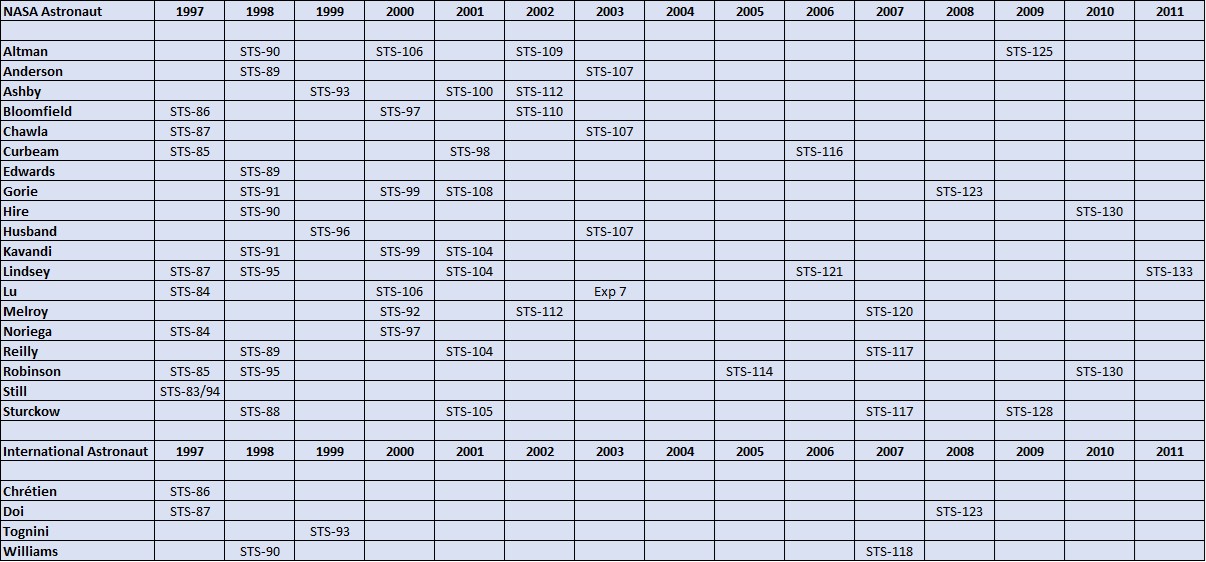
The Group 15 NASA and international astronauts made significant contributions to spaceflight. As a group, they completed 64 flights spending 888 days, or nearly two and a half years, in space, including the three flights Chrétien and Tognini completed before their addition to the group. One Flying Escargot made a single trip into space, nine made two trips, eight made three, four made four, and one went five times. Seventeen of the 23 participated in the assembly, research, maintenance, logistics, and management of the space station. In preparation for space station operations, ten group members visited Mir, and seven visited both space stations, but only one completed a long-duration flight. Twelve contributed their talents on Spacelab or other research missions, and three performed work with the great observatories Hubble and Chandra. Eight of the 23 performed 25 spacewalks spending 161 hours, or more than six days, outside their spacecraft.






